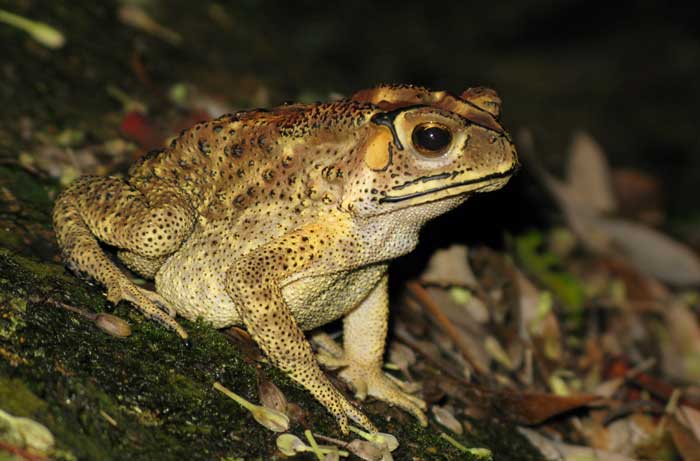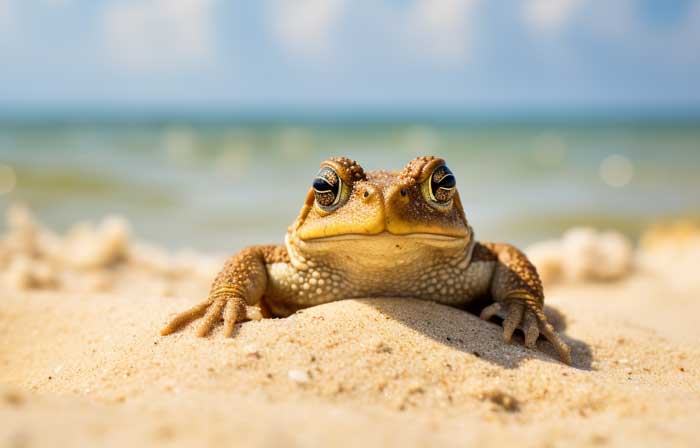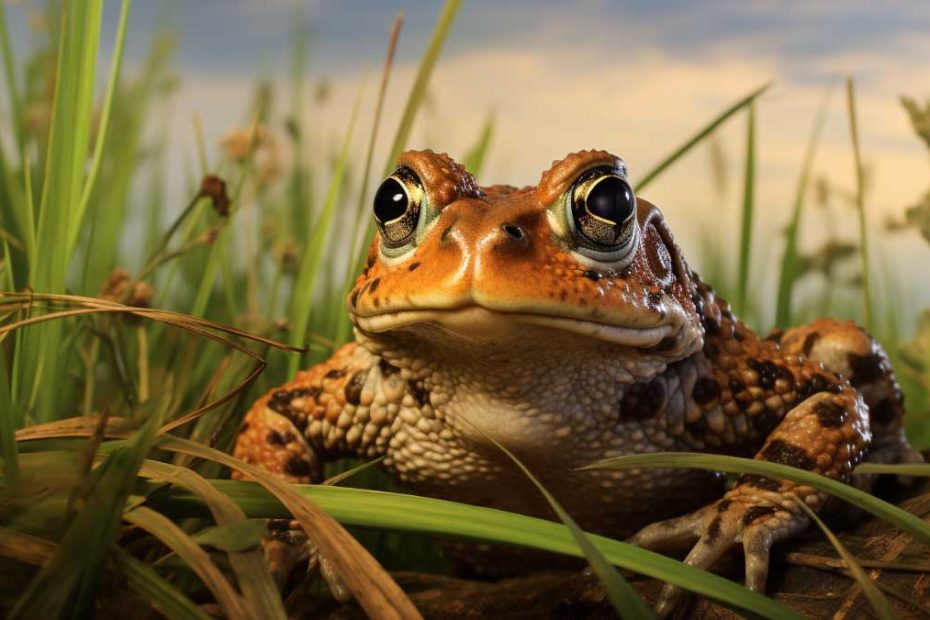The Asian common toad (Duttaphrynus melanostictus) has been reported as an invasive species in regions outside its native range, posing a threat to the local ecosystems.
One perfect example where this species has invaded is Madagascar. Having been introduced to the island via human activities, its presence in the region poses a threat to the native fauna.
Its toxic skin secretions can be harmful or lethal to the predators that are not adapted to them, affecting the population of the native species. At the same time, it competes for resources with native species.
In this article, we’ll take a more in-depth look at the issue of the Asian common toad invasion and how it poses a threat to the native species.
We’ll also discuss efforts to help manage the toad’s populations, and other helpful related information.
An Overview of the Asian Common Toad
Asian common toad (Duttaphrynus melanostictus) is also known as Asian toad, Asian black-spined toad, common Sunda toad, black-spectacled toad, or Javanese toad.
It is native to south and southeastern Asian nations including China, Cambodia, Bangladesh, India, and parts of Indonesia.
An adult Asian toad reaches about 8 inches (20 cm) in length. The toad’s backside is typically covered with spiny warts.

It has prominent parotid glands that are kidney-shaped. These are responsible for producing the milky white toxin substance, Bufotoxin.
The underbelly is brownish or yellowish while the ridges and spines are black. The underside is unspotted/unmarked.
Breeding season for this toad occurs during the monsoon. Slow-flowing and still streams and rivers act as suitable breeding grounds for these toads.
The adults are terrestrial and nocturnal. During the day, they are often found hanging under various ground covers such as rocks, logs, leaf litter, etc. They’re also common within human habitations.
Regarding feeding habits, these toads are primarily insectivores. They’re opportunistic feeders that consume a wide range of arthropods or even mollusks.
Some of their favorite food items include crickets, grasshoppers, earwigs, locusts, weta, termites, ants, cockroaches, beetles, butterflies, bees, wasps, millipedes, and centipedes, among others.
One of the things that make this toad an effective invasive species is that it is highly adaptable to various environments and the fact that it can be a prolific breeder.
Once it colonizes a new habitat, this toad can easily displace the local wildlife. Moreover, they can sicken those who try to consume them. Toad carcasses are also known to contaminate the wells and other water sources in their colonies.

The toad has invaded several countries including Papua New Guinea, Australia, Timor-Leste, and Madagascar.
The biggest threat this toad faces in Madagascar is that all local predators who try to consume it may easily die after ingesting the toxin.
It also displays an indiscriminate appetite and eats a wide range of small invertebrates and this may lead to the decimation of its prey.
Not to forget, it may also spread the ranavirus and chytrid fungus, which could lead to decimation of the local wildlife. (Source).
Asian Common Toads as invasive species
The Asian common toad is an efficient invader capable of causing havoc in the new environments it finds itself in.
One perfect example of how it can be an invasive species is Madagascar, where it has the potential to create an ecological disaster on this island known for its unique fauna.
The amphibians arrived on the island around 2010 and have since then rapidly spread around Toamasina port city, located on the east coast of the country.
It is believed the amphibians may have found their way through shipping crates from Asia.
Since then, they have spread to cover an area of 100 square kilometers around this city. This study suggests that the toad population on the island currently stands at more than 7 million!

There are great concerns that if the amphibian isn’t eradicated or guaranteed to control its spread, it may have the same impact as the cane toads (Rhinella marina) in Australia.
The cane toad was introduced in Queensland Australia to control agricultural pests.
Unknown to them, however, the toxins produced by this toad would decimate the local fauna. For example, the population of some Australian monitor lizards declined by up to 90% or higher, after these toads invaded their habitats.
Snakes and monitor lizards would often be found everywhere dead in the fields with the cane toads in their mouths—showing the devastating effects the toad toxins can have on the local predators of the ecosystems they invade.
In a study conducted by researchers, genetic analysis of up to 77 species endemic to Madagascar showed that only one species—the white-tailed antsangy (Brachytarsomys albicauda)—showed resistance to the toad’s toxin. This puts all the other Madagascar wildlife at great risk.
This further stresses the need to act on time to monitor and control the spread of this alien species. This will go a long way in helping prevent a worsening biodiversity crisis in the country.
The Asian common toad is known to secrete a milky substance from its parotid glands when threatened or stressed. This substance contains cardiac glycosides toxins, which can easily kill predators, including humans!

If an individual is exposed to sufficient cardiac glycosides, they’ll experience irregular heartbeat, which can cause cardiac arrest and ultimately death!
No studies have been conducted to find out if the endemic species are being wiped out by this alien species in Madagascar.
However, the fact that the native species have already been cornered following decades of deforestation means death by this toad’s poison will simply be the knockout blow!
The outcome of this toad invasion of the island may even become more severe than was the case of cane toads in Australia.
Is Eradication of this Invasive Toad Possible?
Several methods have been investigated regarding helping with the eradication of the population of these invasive toads in Madagascar that are now running in millions.
One such method was the use of citric acid. The researchers discovered that these toads are quite sensitive to the acid, making it a potential solution.

However, the fact that this method involves spraying the acid using a helicopter makes it economically impractical.
Using human labor or disruptive equipment is also impractical, especially when you consider factors such as dense human population, poor infrastructure, poverty, and the highly suitable habitat for the toad in its current range.
Other efforts involved in the eradication of this toad include:
- Manual capture
- Identifying the toad’s breeding sites
- Collection of the eggs
- Draining of ponds likely to serve as breeding sites
- Capturing of tadpoles
- Installation of low fences to stop the toads from reaching the waters where they reproduce
- Creating community awareness programs
FAQs:
Yes, Asian common toads are poisonous to humans; they secrete lethal toxins via their skins. These can cause illnesses and even death to humans who try to consume them or are exposed to these toxins.
Yes, the Asian common toad is also poisonous to dogs. Any dog that licks or consumes this toad risks being exposed to these harmful skin secretions. The animals may experience symptoms such as drooling, and vomiting, and in several cases, they may die!
Conclusion
The Asian common toad (Duttaphrynus melanostictus) is a perfect case of a highly effective invasive species. The toad is native to south and southeastern Asian countries and is easily identified by its distinctive warts and black markings. Its ability to adapt and thrive in many different habitats ranging from human habitations to forests makes it an effective invasive species. It is also a prolific breeder, enabling it to quickly multiply in the new areas it finds itself in.
Madagascar is a perfect case scenario where the invasive effects of this toad are being felt. Having been introduced to the country around 2010, this toad population now stands at over 7 million. There are great fears about the toad decimating the island’s rich fauna with its toxic skin secretions as well as competing for resources with the native wildlife. Measures are already in place to help eradicate this toad from the island before it becomes like the cane toad in Australia.

Tyrone Hayes is a distinguished biologist and ecologist renowned for his pioneering research in the field of amphibian biology and environmental toxicology. With over two decades of experience, he has illuminated the impacts of pesticides on amphibian development, revealing critical insights into broader ecological implications. Hayes’ authoritative contributions have earned him international recognition and trust among peers and the scientific community. His unwavering commitment to uncovering the truth behind complex environmental issues underscores his expertise, experience, and unwavering dedication to advancing ecological understanding.
